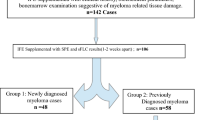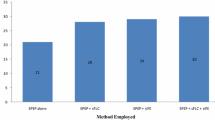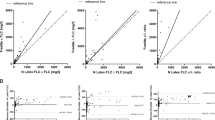Abstract
Conventionally, serum protein electrophoresis (SPE) and serum immunofixation electrophoresis (IFE) are used as primary methods to diagnose and monitor multiple myeloma (MM). Recently, serum-free light chain (FLC) assay has been incorporated into hematological screening programs for myeloma. The purpose of this study is to compare the performance of the three methods in monitoring MM patients after autologous stem cell transplantation (ASCT). SPE, serum IFE and serum FLC assay were performed on 38 MM patients who underwent ASCT. In total, four patients had unexpected protein bands (UPBs) and 13 patients had relapsed after ASCT. Our results indicate that IFE is more sensitive than SPE and FLC assay in detection of UPBs and relapse. The results of IFE may provide useful information in advance of patient relapse.


Similar content being viewed by others
References
Palumbo, A., Sezer, O., Kyle, R., et al. (2009). International Myeloma Working Group guidelines for the management of multiple myeloma patients ineligible for standard high-dose chemotherapy with autologous stem cell transplantation. Leukemia, 23, 1716–1730.
Dimopoulos, M., Terpos, E., Comenzo, R. L., et al. (2009). International Myeloma Working Group consensus statement and guidelines regarding the current role of imaging techniques in the diagnosis and monitoring of multiple myeloma. Leukemia, 23, 1545–1556.
Kyle, R. A., & Rajkumar, S. V. (2009). Criteria for diagnosis, staging, risk stratification and response assessment of multiple myeloma. Leukemia, 23, 3–9.
Kim, S. K., Jeong, T. D., Kim, S. Y., et al. (2014). Characteristics of unexpected protein bands in multiple myeloma patients after autologous stem cell transplantation. Clinical Biochemistry, 47, 588–592.
Abadie, J. M., & Bankson, D. D. (2006). Assessment of serum free light chain assays for plasma cell disorder screening in a Veterans Affairs population. Annals of Clinical and Laboratory Science, 36, 157–162.
Bakshi, N. A., Gulbranson, R., Garstka, D., Bradwell, A. R., & Keren, D. F. (2005). Serum free light chain (FLC) measurement can aid capillary zone electrophoresis in detecting subtle FLC-producing M proteins. American Journal of Clinical Pathology, 124, 214–218.
Katzmann, J. A., Abraham, R. S., Dispenzieri, A., Lust, J. A., & Kyle, R. A. (2005). Diagnostic performance of quantitative kappa and lambda free light chain assays in clinical practice. Clinical Chemistry, 51, 878–881.
Katzmann, J. A., Clark, R. J., Abraham, R. S., et al. (2002). Serum reference intervals and diagnostic ranges for free kappa and free lambda immunoglobulin light chains: Relative sensitivity for detection of monoclonal light chains. Clinical Chemistry, 48, 1437–1444.
Hutchison, C. A., Plant, T., Drayson, M., et al. (2008). Serum free light chain measurement aids the diagnosis of myeloma in patients with severe renal failure. BMC Nephrology, 9, 11.
Levinson, S. S. (2011). Complementarily of urine analysis and serum free light chain assay for assessing response treatment response: Illustrated by three case examples. Clinica Chimica Acta: International Journal of Clinical Chemistry, 412, 2206–2210.
Cavo, M., & Baccarani, M. (2006). The changing landscape of myeloma therapy. New England Journal of Medicine, 354, 1076–1078.
Kumar, S. K., Rajkumar, S. V., Dispenzieri, A., et al. (2008). Improved survival in multiple myeloma and the impact of novel therapies. Blood, 111, 2516–2520.
Hall, S. L., Tate, J., Gill, D., & Mollee, P. (2009). Significance of abnormal protein bands in patients with multiple myeloma following autologous stem cell transplantation. The Clinical Biochemist Reviews, 30, 113–118.
Zent, C. S., Wilson, C. S., Tricot, G., et al. (1998). Oligoclonal protein bands and Ig isotype switching in multiple myeloma treated with high-dose therapy and hematopoietic cell transplantation. Blood, 91, 3518–3523.
Hovenga, S., de Wolf, J. T., Guikema, J. E., et al. (2000). Autologous stem cell transplantation in multiple myeloma after VAD and EDAP courses: A high incidence of oligoclonal serum Igs post transplantation. Bone Marrow Transplantation, 25, 723–728.
Abraham, R. S., Clark, R. J., Bryant, S. C., et al. (2002). Correlation of serum immunoglobulin free light chain quantification with urinary Bence Jones protein in light chain myeloma. Clinical Chemistry, 48, 655–657.
Durie, B. G., Harousseau, J. L., Miguel, J. S., et al. (2006). International uniform response criteria for multiple myeloma. Leukemia, 20, 1467–1473.
Kraj, M. (2014). Immunoglobulin heavy chain/light chain pairs (HLC, Hevylite) assays for diagnosing and monitoring monoclonal gammopathies. Advances in Clinical and Experimental Medicine : Official Organ Wroclaw Medical University, 23, 127–133.
Bahlis, N. J. (2012). Darwinian evolution and tiding clones in multiple myeloma. Blood, 120, 927–928.
Egan, J. B., Shi, C. X., Tembe, W., et al. (2012). Whole-genome sequencing of multiple myeloma from diagnosis to plasma cell leukemia reveals genomic initiating events, evolution, and clonal tides. Blood, 120, 1060–1066.
Walker, B. A., Wardell, C. P., Melchor, L., et al. (2012). Intraclonal heterogeneity and distinct molecular mechanisms characterize the development of t(4;14) and t(11;14) myeloma. Blood, 120, 1077–1086.
Ayliffe, M. J., Behrens, J., Stern, S., & Sumar, N. (2012). Association of plasma cell subsets in the bone marrow and free light chain concentrations in the serum of monoclonal gammopathy patients. Journal of Clinical Pathology, 65, 758–761.
Keats, J. J., Chesi, M., Egan, J. B., et al. (2012). Clonal competition with alternating dominance in multiple myeloma. Blood, 120, 1067–1076.
Kuhnemund, A., Liebisch, P., Bauchmuller, K., et al. (2009). ‘Light-chain escape-multiple myeloma’-an escape phenomenon from plateau phase: Report of the largest patient series using LC-monitoring. Journal of Cancer Research and Clinical Oncology, 135, 477–484.
Zamarin, D., Giralt, S., Landau, H., et al. (2013). Patterns of relapse and progression in multiple myeloma patients after auto-SCT: Implications for patients’ monitoring after transplantation. Bone Marrow Transplantation, 48, 419–424.
Acknowledgments
This study was supported by the National Natural Science Foundation of China (Grant Nos. 81472296, 81101867, 81272542, 81200369 and 81372443), Jiangsu Provincial Special Program of Medical Science (BL2012005), Jiangsu Province’s Key Medical Center (ZX201102), the Priority Academic Program Development of Jiangsu Higher Education Institutions (PAPD), National clinical key subject construction project, National Public Health Grand Research Foundation (No. 201202017), National High-tech R&D Program (863 Program) (2011AA020105), the China International Medical Foundation (Grant No. CIMF–F–H001–057), the Medical Scientific Research Project of Jiangsu Provincial Bureau of Health (Grant No. Z201206), the Special Foundation of Wu Jieping Medical Foundation for Clinical Scientific Research (Grant Nos. 320.6753.1225 and 320.6750.12242) and a Project Founded by the Priority Academic Program Development of Jiangsu Higher Education Institutions.
Conflict of interests
The authors claim no conflict of interests.
Author information
Authors and Affiliations
Corresponding authors
Rights and permissions
About this article
Cite this article
Li, W., Zhou, JZ., Chang, HR. et al. Comparison of SPE, IFE, and FLC in Monitoring Patients with Multiple Myeloma After Autologous Stem Cell Transplantation. Cell Biochem Biophys 73, 643–647 (2015). https://doi.org/10.1007/s12013-015-0655-z
Published:
Issue Date:
DOI: https://doi.org/10.1007/s12013-015-0655-z




